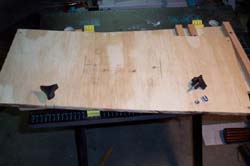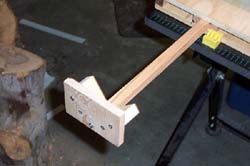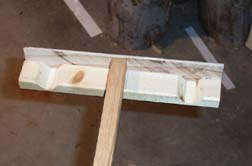Building a Lathe Tool Sharpening Jig
Introduction
This article was originally posted to my blog, woodbox23.
This holiday season (2005) my lovely lady wife asked me what I wanted for Christmas. Since my hobby is hard to buy for, we often have these conversations. One of the things I had mentioned was a 8″ Slow Speed Grinder I had seen at Woodcraft (on sale no less) for sharpening lathe chisels. Something I haven’t really mastered the art of yet, but it’s hard to get good results on 80 grit 6″ grinder wheel. Amazingly enough, she said yes, and I was a happy happy boy.
The thing that would make it so much better of course would be a Oneway Wolverine Sharpening Jig, but alas, finances being what they are, I couldn’t really ask Santa for that after getting the grinder. So I set out to make one out of stuff I could find around the shop, and a little bit of hardware from the hardware store. I also wanted it to be portable, or at least movable in my shop, since I’m starting to run out of bench top space. I decided to build it so that I could mount it on my folding work table when I wanted to use it, and put it out of the way when I wasn’t using it or needed the space. I decided to take some pictures along the way, so I could share. Click a thumbnail to see a larger version of it.
Parts List:
- Plywood and other scrap wood
- 10′ 3/4″ square Oak molding
- Various wood screws
- 2 Barbed Threaded Inserts (for 1/4 x 20)
- 2 knobs 1/4 x 20 threaded male end
Assembly:
I first figured out what size would fit best on the the clamping work surface of my folding work table. I came up with 10″ that would fit securely and have good support. I had some 24″ x 48″ Plywood sheets, so I cut two lengths of 10″ x 24″ plywood for the top and bottom. Then I cut 6 lengths of Oak at 10″ each.
I screwed 2 sections of 10″ oak to the ends of the bottom board, this would be for supporting the outside edges. (I forgot to take a picture of this step, but you can see them in this picture as well. Just ignore those bits in the middle.)
I then bolted the Grinder to the top board, centered it as best I could.
Then I set the top board onto the bottom board, and put the other four 10″ oak pieces in place, moving them around until they lined up with the grinder wheels. Once I had them positioned, and I could move another piece of oak smoothly between them I marked the positions. The I pulled the top board off, set it aside, and drilled and screwed the inside pieces. I guess we could call them rails because they function as a guide to keep the sliding bar straight and in line with the wheels. I made sure they were square to the board, and that the oak piece could still slide well. I also added a chunk of oak board I had in my scrap bin to add some extra support for the weight of the grinder that would be sitting on top of it.
Now that the rails were set, and the bottom parts were all in place, and screwed down, I removed the grinder from the top board to install the tightening knobs. I had picked up a couple Barbed Threaded Inserts at the hardware store for this project. I ‘d never used one before, but they sure are neat! I think I might make a couple of marking gauges with these later. I used oak molding because I figured it would stand up to the tightening of the screw knob and stuff. I drilled the holes, and pounded the inserts into the wood. They fit well, although I think I over did it a little, I had to work the knobs in and out a couple of times to get them to turn smoothly, but they I had really pounded on them, and I think I deformed the top threads a bit. 🙂 I decided to mount the knobs in the back so that they wouldn’t get in the way of the tools being ground, or any future tool rests I might put on this. The positioning wasn’t totally convenient but it works well enough.
That done, I mounted the grinder back on the top board, and put it back onto the bottom board. I marked off the spots to drill holes for screwed along the outside edge, and in the back on the rails to hold down the top board when the knob gets tightened on the sliding bar. I might need to add more screws here, but it’s hard to get at with the grinder mounted. I’ll watch that area for strain after it’s been used a bit. Here is a shot of it assembled but not screwed together all the way. I did a lot of test fitting to make sure everything was going to fit before screwing everything together.

Next step, now that I had every thing fitting well, was to screw it all together making sure it was tight. I also tested the clamping table, and made sure it would be secure when clamped. I did make a minor miscalculation with the knobs that the table uses for clamping getting in the way of the sliding rod, but all I have to do is slide the whole thing sideways and it works pretty well. Here are some assembled shots, front and back of it clamped into the table.


The next stage would be to figure out how to make the sliding arm. I had the rails set, and the arm it self was no problem, just 30″ of the oak 3/4″ stock. I needed a pocket on the end to hold the butt of the lathe chisel. I put together a few pieces of scrap wood into something that worked out ok, but I think it needs some work. The chisel has a little too much room to move around in, so I think I need to build another one, but for now it will work just fine. Here is what I came up with.
And after a couple of hours of work and a bit of scrap wood, I put together a pretty nice looking jig for sharpening my chisels. I think it’ll take some practice to get a good grind, but the jig will help me get a good consistent grind on my gouges, something I’ve not been able to do up till now. The grinder will help me a lot as well, so I’m looking forward to some pretty lathe chisels, and more fun turning!
Final Pictures with my gouge sitting in position!


UPDATE:
I updated the gouge sharpening arm today, to have a better pocket. I cut and shaped some scrap cedar I had laying around to fit into the pocket, and make a proper V shape to it, so that the butt end of the chisel doesn’t move around laterally. It worked great!
UPDATE:
I also created a skew sharpening arm for the sharpening jig, and it worked beautifully! I took some 1 x 2 out of the scrap bin, and cut some v-grooves in it, about 3 1/2 inches from the center of the wheel. I cut the notches by tilting my table saw wheel to 45 degrees, and cranking it down as low as it would go. Then I made repeated passes till I had a nice V groove cut into the wood at the appropriate spots. I screwed some wood to the back, and screwed it onto the left over piece of Oak 3/4″ molding that I used for the other arm. The skew just sits in the pocket, and puts a perfect edge on my skew. I was doing some spindle work today, and it came out better than I’ve ever done. Very sharp. Here are the pictures:
Hope this helps you out, and happy sharpening!
— Badger










this looks good. My wife and I are just getting into turning and sharpening has become a real issue. sometimes things go very well but other times I should just take the tool back to the grinder. I will give this a try and see how it works for me
Don
Thanks so much for your time and effort to create this article. I used it to build my own and it is great. Didn’t have the money to buy a store bought. This is much better. Thanks again, Roger
great article and pictures,i’ve just started turning and am looking forward to making this,i too haven’t the money to buy..thanks,
Rachel